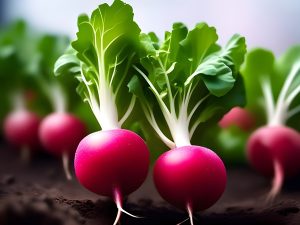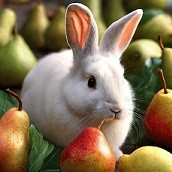Can Rabbits Eat Radish Tops? Diet, Safety & Tips on Optimal Quantity & Preparation
Radish tops, or the green leafy part that

What are Radish Tops?
Radish tops are the leafy greens attached to the radish root. While radishes are cultivated mainly for their crunchy roots, the tops are completely edible and packed with nutrition. They have a slightly peppery taste, somewhat milder than the root, and can add a fresh bite to salads for humans.
Alternative Names
Depending on where you reside or shop, radish greens might also be referred to as:
- Radish leaves
- Radish leafy greens
- Radish green tops
Can Rabbits Consume Radish Tops?
Yes! Rabbits can definitely eat radish tops. In fact, the leafy parts of
Optimal Quantity
Rabbits thrive on a diet rich in fiber, and hay should make up about 70-80% of their dietary intake. When introducing radish tops, or any new
Benefits of Radish Tops
- Rich in Nutrients: Radish greens are a good source of vitamins A, C, and K. They also provide essential minerals like iron, magnesium, and calcium.
- High in Fiber: The fiber content helps in digestion and can aid in preventing gastrointestinal stasis, a common concern for rabbits.
- Low in Calories: This makes them an ideal snack for bunnies.
Rabbits and Radish Tops: Can They Eat Them and Nutritional Information
| Feature | Description | Reference Number |
|---|---|---|
| Can pet rabbits eat radish tops? | Yes, rabbits can eat radish tops in moderation. Radish tops are a good source of fiber, vitamins A and C, and calcium. However, they are also high in oxalic acid, which can cause health problems if consumed in large quantities. | 1 |
| Benefits of radish tops for rabbits | Radish tops can provide rabbits with essential nutrients such as fiber, vitamins A and C, and calcium. They can also help promote healthy digestion and prevent gastrointestinal problems. | 2 |
| Nutritional value of radish tops | Radish tops are a good source of fiber, vitamins A and C, and calcium. They also contain iron, potassium, and magnesium. | 3 |
| Serving size for rabbits | Radish tops should be fed to rabbits in moderation, as they are high in oxalic acid. A small handful of radish tops once or twice a week is a safe serving size for most rabbits. | 1 |
| Precautions when feeding radish tops to rabbits | Rabbits should not be fed large quantities of radish tops, as they are high in oxalic acid and can cause health problems. It is also important to wash radish tops thoroughly before feeding them to rabbits to remove any pesticides or other contaminants. | 4 |
Warnings
- Always Wash Thoroughly: Before serving radish tops or any vegetable, make sure they are washed properly to remove any pesticides or chemicals.
- Observe for Changes: After introducing radish tops, monitor your rabbit for any changes in behavior, stool consistency, or appetite. This will help in ensuring they’re not negatively affected.
Alternative Foods
If you’re keen on diversifying your rabbit’s diet, consider these alternatives:
- Lettuce (Romaine or Butterhead)
- Carrot tops
- Cilantro
- Basil
- Spinach (in moderation due to high oxalates)
FAQs
Can rabbits eat the radish root?
While not toxic, radish roots can be quite spicy and might not be relished by all rabbits. If you decide to offer it, do so in moderation and observe how your rabbit reacts.
How often can I feed my rabbit radish tops?
Two to three times a week in moderation is a good measure. However, ensure that you’re providing a mix of other leafy greens to ensure a balanced diet.
Should I mix radish tops with other veggies?
Absolutely! Rabbits enjoy variety. Mixing radish tops with other bunny-safe vegetables can provide a nutritional and exciting meal for them.
Can young rabbits eat radish tops?
While they can, it’s advisable to wait until a rabbit is older (above 12 weeks) before introducing vegetables, including radish tops.
In summary, radish tops can be a wonderful addition to your rabbit’s diet, offering both nutrition and variety. Always remember to introduce any new food gradually and monitor your bunny for any adverse reactions. With the right care and diet, you’ll have a happy, hopping friend for years to come!







Leave a Reply